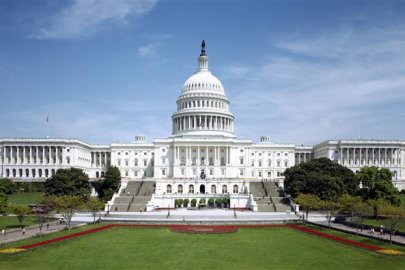The U.S. Department of Energy's Federal Energy Management Program (FEMP) provides direct funding to federal agencies through the AFFECT grant program. AFFECT offers grants for developing energy and water efficiency projects and processes at U.S. federal government-owned facilities.
On March 23, 2023, the Biden-Harris Administration, through the U.S. Department of Energy (DOE), announced $250 million in funding from President Biden's Bipartisan Infrastructure Law to help federal agencies implement net-zero building projects and set an example in sustainability as the nation works to transition to clean energy and combat climate change.
The AFFECT BIL FAC aligns with goals for federal leadership in energy efficiency and sustainability, as outlined in the Energy Act of 2020 and Executive Orders 14057 and 14008. The funding opportunity seeks applications for projects that will contribute to a net-zero building portfolio, serving as models for future projects and fostering a long-term strategy for net-zero buildings across federal agencies.
-
 In January 2024, FEMP announced 31 federal agency projects to receive the first disbursement, totaling $104 million in AFFECT funding.
In January 2024, FEMP announced 31 federal agency projects to receive the first disbursement, totaling $104 million in AFFECT funding.
-
 In October 2024, FEMP announced nearly $150 million in funding for 67 energy conservation and clean energy projects at federal facilities across 28 U.S. states and territories and six international locations.
In October 2024, FEMP announced nearly $150 million in funding for 67 energy conservation and clean energy projects at federal facilities across 28 U.S. states and territories and six international locations.
Key Dates
- Spring 2025: AFFECT 2025 call for applications opens
Eligibility
Eligible Applicants
- AFFECT is available to U.S. federal agencies ONLY, including sub-agencies.
- Only facilities owned by the U.S. federal government are eligible for funding under this FAC.
- For projects at government-owned, contractor-operated facilities, the application must be submitted by the Federal Contracting Officer. The federal agency must pay the utility bills, receive the benefits of reduced utility bills, and, in the case of a performance contract, pay the energy service company (ESCO)/utility.
Coordination
Eligible applicants can work with national laboratories, ESCOs, utilities, or contractor partners to develop application content. However, the application must be submitted by the eligible federal agency.
Eligible Project Costs
AFFECT BIL grant funding can be used for equipment, technical assistance, and other services related to the planning, development, or implementation of eligible projects.
AFFECT Topic Areas
The AFFECT BIL FAC covers four distinct Topic Areas, providing a framework for federal agencies to develop projects that contribute to energy efficiency, sustainability, and the reduction of carbon emissions.
Topic Area 1A: Assistance with Net-Zero Buildings Project Development
This Topic Area focuses on supporting the development of individual net-zero buildings projects. It aims to overcome barriers between the initial concept and project initiation phases, facilitating the transition to net-zero building practices. Examples of assistance include analyzing the transition from fossil-fuel-based systems to all-electric systems and conducting financial analyses to maximize project scope and impact.
Topic Area 1B: Assistance with Net-Zero Buildings Program/Procedures Development
Topic Area 1B is dedicated to initiating, developing, or modifying agency programs or procedures to create a pipeline of net-zero buildings projects. It aims to establish frameworks and procedures that enable the systematic integration of net-zero building principles across agency operations. Examples of assistance include portfolio analysis of viable net-zero buildings opportunities and the development of campus master plans for achieving net-zero emissions, water, and/or waste.
Topic Area 2: Modify Existing Projects for Net-Zero Buildings
In this Topic Area, the focus is on modifying existing projects to incorporate net-zero buildings energy conservation measures. Agencies can enhance previously awarded contracts by integrating measures that align with the goals outlined in executive orders and legislative acts. Examples include electrifying heating systems and implementing renewable energy technologies to reduce carbon emissions and enhance energy efficiency.
Topic Area 3: New/In Development Net-Zero Buildings Projects
Topic Area 3 supports the initiation of new projects or the development of projects that contribute to net-zero buildings goals. It encourages agencies to explore innovative approaches to design and construction that prioritize energy efficiency, sustainability, and resilience. Examples include implementing solar and battery systems to provide continuity of critical missions during utility outages and steering entire bases towards net-zero energy consumption.
Steps to Apply
- Obtain a control number: Begin the application process on the Clean Energy Infrastructure eXCHANGE to receive a control number. This number must be displayed on the upper right corner of every page.
- Complete required forms: Access application forms, the letter of endorsement template, eProject Builder calculating templates, and more under "Application Forms and Templates" on the Clean Energy Infrastructure eXCHANGE.
- Submit application
- All applications must be submitted via the Clean Energy Infrastructure eXCHANGE.
- The Clean Energy Infrastructure eXCHANGE will open for submissions three months ahead of each phase's deadline.
- Applications must be submitted by 5 p.m. ET on the applicable deadline date. Applicants are strongly encouraged to submit their applications at least 48 hours in advance.
- Applications submitted through other means or after the deadline will not be considered.
Best Practices for Applicants
- Read grant announcements carefully: Understand the requirements and past successful projects.
- Access required systems: Ensure you have necessary accounts and access.
- Coordinate with key personnel: Engage procurement and contracting officers early.
- Ensure accuracy: Maintain consistency and accuracy in your application.
- Leverage funding sources: Combine federal and non-federal funding to meet performance contract requirements.
- Comprehensive projects: Aim for projects that meet multiple agency goals.
- Utilize FEMP's services: Use available technical assistance and training from FEMP.
Application Reviewers
FEMP requires a diverse pool of individuals to review applications submitted to this FAC. Reviewers are asked to commit up to 40 hours reviewing applications and have subject matter expertise in at least one of the following areas:
- Benefits of Net-Zero Buildings Projects
- Energy and Cost Savings of Net-Zero Buildings Projects
- Net-Zero Buildings Program Viability
- Value and Funding Impact of Net-Zero Buildings Projects
- Viability, Risks, Replicability, and Scalability of Net-Zero Buildings Projects
The benefits of reviewing can include:
- Bringing your professional expertise to help inform funding decision.
- Gaining practical knowledge of the merit review process.
Selected reviewers must sign a nondisclosure agreement. In addition, DOE ensures selected reviewers do not have conflicts of interest prior to initiating any independent review processes.
Frequently Asked Questions (FAQs)
A: This FAC is available to federal agencies ONLY, including sub-agencies (5 U.S.C § 551(1)).
- Only facilities that are owned by the U.S. federal government are eligible (42 U.S.C. § 8253).
- This FAC is not limited to domestic facilities (Section III.A of the FAC).
A: For a project at a government-owned, contractor-operated facility to be eligible, the application must be submitted by the cognizant Federal Contracting Officer and the following requirements must be met (see Section III.A of the FAC):
- The federal agency must pay the utility bills.
- The agency must receive the benefits of the reduced utility bills.
- In the case of a performance contract, pay the ESCO/utility.
A: Applicants selected for an award will have the opportunity to discuss and negotiate project-specific deliverables and a timeline for funding distribution as noted in section II.D of the FAC.
- Once the funds have been distributed to the applicant, how they are further distributed and managed will be subject to the recipient agency's policies and procedures.
- It is recommended that an applicant consult with their agency contracting officer and project team.
A: Per section III.D of the FAC:
- "FEMP will not make eligibility determinations for potential applications prior to the date on which applications to this FAC must be submitted.
- The decision whether to submit an application in response to this FAC lies solely with the applicant."
A. Under an ESPC, payments to an ESCO must come from savings that result from the ESPC and must be from funds appropriated or otherwise made available to the agency for the payment of energy, water, or wastewater treatment expenses, including related operations and maintenance (O&M) expenses and repair and replacement (R&R) costs. (42 U.S.C. §§ 8287(a)(1) and 8287a) To the extent an ESPC avoids the need to spend funds on energy, water, wastewater, or related O&M or R&R expenses, such avoided costs are savings under an ESPC. Savings from avoided costs can include grant funds that otherwise would have been spent on energy, water, wastewater, or related O&M or R&R expenses.
The authority for AFFECT awards (42 U.S.C. § 8256(b)) expressly provides that funding will be provided in the form of competitive "grants" to assist agencies in meeting their requirements under 42 U.S.C. § 8253. Under 42 U.S.C. § 8253 agencies are statutorily directed to implement certain energy- or water-saving measures using performance contracting. (42 U.S.C. § 8253(f)(4)) To the extent that implementation of energy- or water-saving measures are addressed by an ESPC, the cost of such implementation is avoided by the ESPC and therefore savings. Accordingly, funds made available through an AFFECT grant can be applied as avoided cost savings.
Recommended FEMP Trainings
Key Resources
News
-
 As part of the Biden-Harris Administration's Investing in America agenda, the U.S. Department of Energy opened its second phase of Assisting Federal Facilities with Energy Conservation Technologies (AFFECT) grant funding.March 21, 2024
As part of the Biden-Harris Administration's Investing in America agenda, the U.S. Department of Energy opened its second phase of Assisting Federal Facilities with Energy Conservation Technologies (AFFECT) grant funding.March 21, 2024 -
 FEMP unveiled $104M in clean energy investment across 31 projects under Biden's Bipartisan Infrastructure Law. The Pentagon event highlighted transformative initiatives, federal leadership, and agency collaboration for a more sustainable future.January 24, 2024
FEMP unveiled $104M in clean energy investment across 31 projects under Biden's Bipartisan Infrastructure Law. The Pentagon event highlighted transformative initiatives, federal leadership, and agency collaboration for a more sustainable future.January 24, 2024 -
 Funding from Bipartisan Infrastructure Law Supports Energy Conservation Measures at 31 Facilities, Saving Taxpayers $29 Million in the First Year and Drastically Reducing the Federal Carbon FootprintJanuary 17, 2024
Funding from Bipartisan Infrastructure Law Supports Energy Conservation Measures at 31 Facilities, Saving Taxpayers $29 Million in the First Year and Drastically Reducing the Federal Carbon FootprintJanuary 17, 2024 -
 Federal Energy Management Program (FEMP) Director Mary Sotos joined a White House Council on Environmental Quality meeting of Agency Chief Sustainability Officers to discuss the Assisting Federal Facilities with Energy Conservation Technologies (AFFECT).March 31, 2023
Federal Energy Management Program (FEMP) Director Mary Sotos joined a White House Council on Environmental Quality meeting of Agency Chief Sustainability Officers to discuss the Assisting Federal Facilities with Energy Conservation Technologies (AFFECT).March 31, 2023
Need Assistance?

Need guidance or have questions related to the AFFECT BIL FAC? Direct all questions to [email protected].
For technical help navigating the application system, contact the Clean Energy Infrastructure eXCHANGE helpdesk at [email protected].




